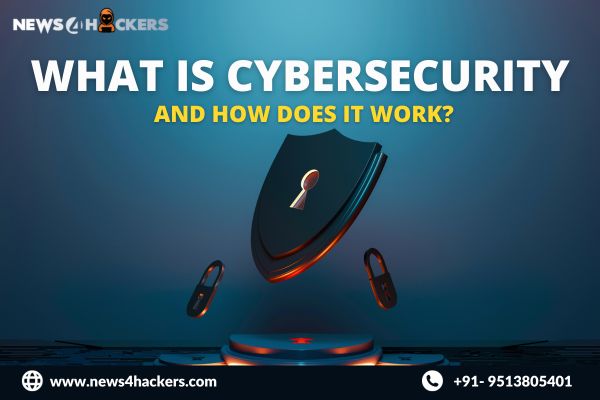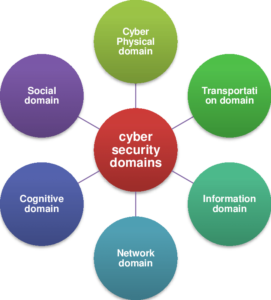What is Cyber Security, and How Does it Work?

Introduction:
The concept of cyber security encompasses a range of methodologies, technologies, and procedures that are employed to safeguard the confidentiality, integrity, and accessibility of computer systems, networks, and data. Its primary objective is to defend against cyber-attacks and prevent unauthorized access. The primary objective of cyber security is to safeguard organizational assets against a range of potential risks, including external and internal attacks, as well as interruptions stemming from natural disasters.
In order to establish a robust and efficient cybersecurity framework, it is imperative to recognize that organizational assets consist of several independent systems. Consequently, a comprehensive approach to cybersecurity necessitates the synchronization of efforts across all information systems inside the business.
What are some of the cyber security sub-domains?

Application Security
Application security encompasses the implementation of diverse protective measures across all software and services utilized within a business, with the aim of safeguarding against an extensive array of potential threats. Minimizing the probability of unauthorized access or alteration of application resources necessitates the undertaking of many measures, including the design of secure application architectures, the authoring of secure code, the implementation of robust data input validation, and the practice of threat modeling, among others.
Identity Management and Data Security
Identity management encompasses a range of concepts, processes, and activities that facilitate the authentication and authorization of bona fide individuals to access information systems within an organizational context. Data security encompasses the implementation of robust techniques for storing information, thereby guaranteeing the security of data both when it is at rest and during its transmission.
Network Security
Network security encompasses the deployment of hardware and software measures to safeguard the network and its infrastructure against unwanted access, interruptions, and misuse. The implementation of robust network security measures plays a crucial role in safeguarding organizational assets from a wide range of both external and internal threats.
Mobile Security
The concept of mobile security pertains to safeguarding both personal and organizational data that is held on mobile devices, including but not limited to cell phones, laptops, and tablets. This protection is necessary to mitigate risks such as unauthorized access, device loss or theft, and the presence of malicious software.
Cloud Security
Cloud security pertains to the development of secure cloud architectures and applications for organizations, employing a range of cloud service providers like AWS, Google, Azure, Rackspace, and others. The implementation of robust architectural designs and meticulous environment configuration plays a pivotal role in safeguarding against a multitude of potential dangers.
Disaster Recovery and Business Continuity Planning (DR&BC)
Disaster Recovery and Business Continuity (DR&BC) encompasses many procedures, including process management, monitoring, alert systems, and strategic planning, which aid businesses in effectively safeguarding their business-critical systems. These measures are designed to ensure the uninterrupted operation of essential systems during and after a disaster, as well as facilitate the recovery and restoration of lost activities and systems following an incident.
User Education
The formal instruction of individuals in computer security matters is crucial for promoting awareness of industry best practices, organizational procedures, and regulations, as well as the monitoring and reporting of hostile activity.
The importance and challenges of cyber security

In light of the dynamic progression of technology and the escalating utilization of software in diverse industries such as finance, government, military, retail, hospitals, education, and energy, among others, a growing volume of information is transitioning into digital formats and becoming readily accessible through both wireless and wired digital communication networks, spanning the ubiquitous realm of the internet. The preservation of highly sensitive information is of considerable significance to individuals engaged in criminal activities and malevolent actions. Consequently, it is imperative to safeguard this information through the implementation of robust cybersecurity procedures and protocols.
In addition, the significance of effective cyber security strategies becomes apparent when considering the notable security breaches experienced by prominent organizations like Equifax, Yahoo, and the U.S. Securities and Exchange Commission (SEC). These incidents resulted in the loss of highly sensitive user data, leading to severe financial and reputational consequences that were difficult to rectify. According to current trends, there is no indication of a decrease in the frequency of cyber-attacks. Every day, companies of various sizes are subjected to deliberate targeting by assailants with the intention of acquiring valuable data or disrupting their services.
Moreover, the dynamic nature of the growing technology world presents difficulties when it comes to the successful implementation of robust cybersecurity solutions. Software undergoes frequent updates and modifications, resulting in the introduction of novel flaws and vulnerabilities, hence rendering it susceptible to a wide range of cyber-attacks.
Moreover, the IT infrastructure undergoes continuous development, as evidenced by numerous firms transitioning their on-premise systems to cloud-based solutions. This migration introduces a distinct array of design and implementation challenges, consequently giving rise to a novel category of vulnerabilities. Many companies lack awareness of the diverse hazards inherent in their IT infrastructure, resulting in a failure to implement adequate cyber security measures until it is too late.
What is a cyber-attack?
A cyber-attack refers to a purposeful endeavor undertaken by external or internal threats or attackers with the intention of exploiting and compromising the confidentiality, integrity, and availability of information systems belonging to a certain business or individual(s). Cybercriminals employ illicit techniques, software, and strategies to inflict harm and disturbances or obtain unauthorized entry into computers, devices, networks, applications, and databases.

Cyberattacks encompass a diverse range of tactics employed by criminals and attackers to exploit software vulnerabilities. The subsequent enumeration serves to underscore several significant methods utilized in such attacks:
- Malware
- Ransomware
- Injection attacks (e.g., cross-site scripting, SQL injection, command injection)
- Session management and Man-in-the-Middle attacks
- Phishing
- Denial of service
- Privilege escalations
- Unpatched/Vulnerable software
- Remote code execution
- Brute force
What’s the difference between a cyber-attack and a security breach?
A cyber-attack and a security breach are not synonymous. As previously mentioned, a cyber-attack refers to an intentional effort to undermine the security measures of a certain system. Adversaries endeavor to exploit the confidentiality, integrity, or availability of software or networks by the utilization of diverse forms of cyber-attacks, as delineated in the aforementioned section. A security breach, conversely, refers to a consequential occurrence or event in which a cyber-attack leads to the compromise of confidential data, unlawful entry into information technology systems, or the disruption of services.
Perpetrators continually employ a diverse range of cyber-attacks against their targets, driven by the persistent belief that one of these attempts will successfully compromise security measures. Therefore, security breaches also underscore an additional crucial component of a comprehensive cyber security plan, namely Business Continuity and Incident Response (BC-IR).
In addition, the implementation of a Business Continuity and Incident Response (BC-IR) framework assists organizations in effectively managing and mitigating the impact of successful cyber-attacks. Business Continuity pertains to the maintenance of essential business systems during a security incident, while Incident Response involves the timely response to a security breach, with the aim of minimizing its consequences and allowing the restoration of both IT and business systems.
11 Top Cyber Security Best Practices To Prevent A Breach

- Conduct cyber security training and awareness
The efficacy of a robust cyber security strategy would be compromised in the absence of comprehensive employee education pertaining to cyber security, corporate policies, and incident reporting. Even the most effective technical safeguards can be compromised when personnel engage in inadvertent or deliberate malevolent behaviors, leading to a significant and expensive breach of security. The most effective approach to mitigating negligence and the risk of security breaches within an organization is through the implementation of educational initiatives such as seminars, lectures, and online courses, which aim to educate employees and enhance their understanding of corporate policies and security best practices.
- Perform risk assessments
It is recommended that organizations undertake a comprehensive risk assessment process in order to identify and prioritize valuable assets based on the potential damage resulting from their compromise. This will assist firms in making informed decisions regarding the optimal allocation of resources towards the protection of individual valuable assets.
- Ensure vulnerability management and software patch management/ updates
Performing identification, categorization, remediation, and mitigation of vulnerabilities within the software and networks utilized by organizational IT teams is of utmost importance in order to mitigate attacks against their IT systems. In addition, it is common for both security researchers and attackers to regularly discover novel vulnerabilities in different software systems. These flaws are subsequently communicated to the respective software makers or disclosed to the general public. These vulnerabilities are frequently targeted by malicious software and individuals engaging in cyber attacks. Software vendors often issue updates that address and mitigate these vulnerabilities. Consequently, ensuring the regular updating of IT systems is essential for safeguarding organizational assets.
- Use the principle of least privilege
The idea of least privilege stipulates that it is required to allocate the minimum level of permissions to both software and personnel in order for them to effectively carry out their respective responsibilities. This measure mitigates the potential consequences of a security breach by ensuring that user accounts and software with fewer rights are unable to compromise important assets that necessitate a higher degree of authorization. Furthermore, it is imperative to implement two-factor authentication for all user accounts with elevated privileges to ensure enhanced security measures.
- Enforce secure password storage and policies
It is imperative for organizations to implement stringent password policies that align with industry best practices, mandating their adoption by all employees. It is imperative to enforce periodic password changes as a measure to enhance protection against hacked credentials. In addition, it is imperative that password storage adheres to the established standards of the industry, which involve the utilization of salts and robust hashing algorithms.
- Implement a robust business continuity and incidence response (BC-IR) plan
The implementation of robust business continuity and incident response strategies and policies is essential for organizations to efficiently address cyber-attacks and security breaches while simultaneously guaranteeing the continuous operation of vital business systems.
- Perform periodic security reviews
The implementation of regular security evaluations for software and networks facilitates the timely detection of security vulnerabilities in a controlled setting. Security reviews encompass several methodologies, such as application and network penetration testing, source code reviews, architecture design reviews, and red team assessments, among others. Once security vulnerabilities are identified, it is imperative for businesses to promptly prioritize and address them in order to limit potential risks.
- Backup data
Regularly performing data backups enhances redundancy and ensures the preservation and integrity of critical data in the event of a security breach. Attacks such as injections and ransomware have the potential to undermine the integrity and availability of data. Backups can serve as a means of safeguarding against such circumstances.
- Use encryption for data at rest and in transit
It is imperative that all confidential data be securely stored and transmitted through robust encryption techniques. The process of encrypting data serves to uphold the principle of confidentiality. It is imperative to establish and implement robust key management and rotation strategies. It is imperative for all web apps and software to incorporate the utilization of SSL/TLS.
- Design software and networks with security in mind
It is imperative to incorporate security measures while developing apps, writing software, and designing networks. It is important to consider that the financial implications of retrofitting software with security measures and doing refactoring are significantly higher compared to incorporating security measures during the initial development phase. The implementation of security measures in application design aids in mitigating potential risks and guarantees that in the event of software or network failures, the system remains secure.
- Implement strong input validation and industry standards in secure coding
Robust input validation is frequently regarded as the initial safeguard against diverse forms of injection attacks. Software and apps are intentionally built to receive user input, which, unfortunately, exposes them to potential attacks. In order to mitigate this vulnerability, robust input validation techniques are employed to effectively identify and filter out malicious input payloads that may be processed by the applications. In addition, it is advisable to employ secure coding standards during software development since they effectively mitigate a majority of the vulnerabilities identified in OWASP and CVE.
Manage Risk at Enterprise Scale
In a nutshell, we at News4Hackers, the Best Cybersecurity Info, and News Portal, always try to keep our readers informed about the ongoing digital incidents that harm mankind in any possible manner. In the same vein, we also attempt to keep abreast of all the possible consequences that individuals and enterprises may face in terms of maintaining the health of their digital assets.
To help people and organizations with the Best XDR Solutions in India and almost every country worldwide, we have developed ShieldXDR, a unit of Craw Security, the sister vertical of News4Hackers that gives a one-stop solution for all your information security training and VAPT solutions for requirements under the prime observation of highly skilled cybersecurity professionals with more than 12 years of quality work experience.
To have a demo session of our world-class XDR Services in India at very affordable rates, give us a call at +91-9513805401 and have an exciting flat 10% discount from News4Hackers.
About The Author:
Yogesh Naager is a content marketer who specializes in the cybersecurity and B2B space. Besides writing for the News4Hackers blog, he’s also written for brands including CollegeDunia, Utsav Fashion, and NASSCOM. Naager entered the field of content in an unusual way. He began his career as an insurance sales executive, where he developed an interest in simplifying difficult concepts. He also combines this interest with a love of narrative, which makes him a good writer in the cybersecurity field. In the bottom line, he frequently writes for Craw Security.
Read More Article Here :





